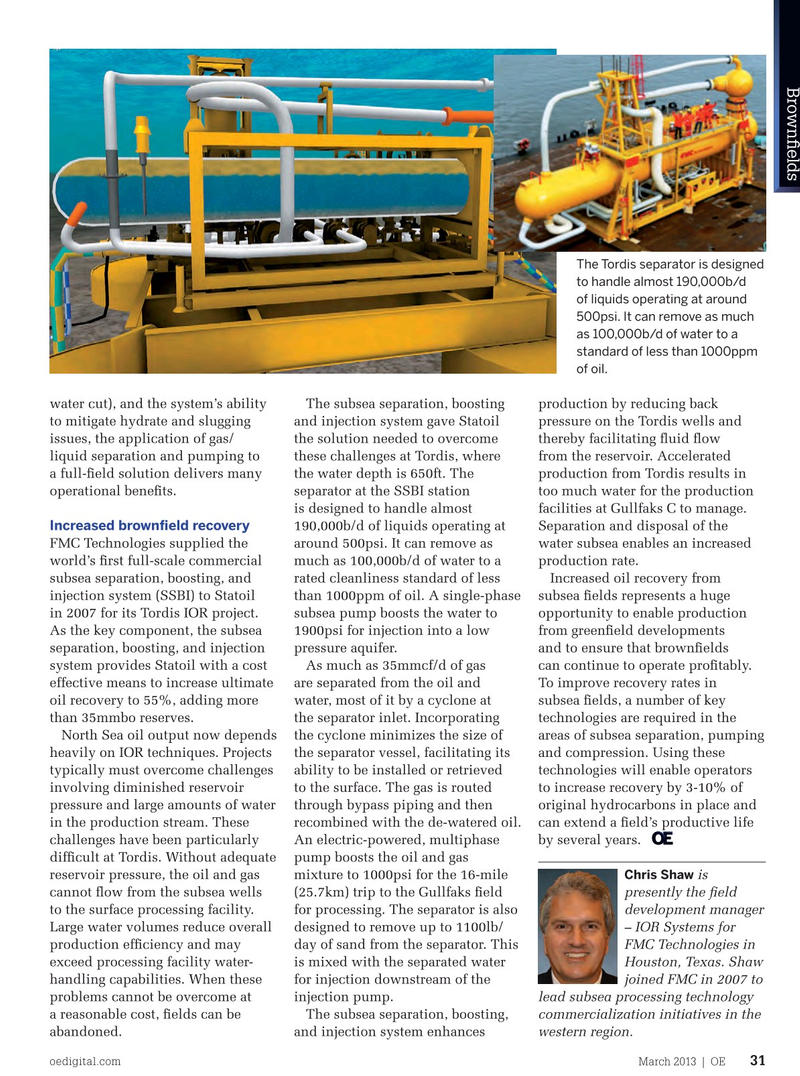
Page 29: of Offshore Engineer Magazine (Mar/Apr 2013)
Read this page in Pdf, Flash or Html5 edition of Mar/Apr 2013 Offshore Engineer Magazine
Brownfelds
The Tordis separator is designed to handle almost 190,000b/d of liquids operating at around 500psi. It can remove as much as 100,000b/d of water to a standard of less than 1000ppm of oil.
water cut), and the system’s ability The subsea separation, boosting production by reducing back to mitigate hydrate and slugging and injection system gave Statoil pressure on the Tordis wells and issues, the application of gas/ the solution needed to overcome thereby facilitating fuid fow liquid separation and pumping to these challenges at Tordis, where from the reservoir. Accelerated a full-feld solution delivers many the water depth is 650ft. The production from Tordis results in operational benefts. separator at the SSBI station too much water for the production is designed to handle almost facilities at Gullfaks C to manage.
Increased brownfeld recovery 190,000b/d of liquids operating at Separation and disposal of the
FMC Technologies supplied the around 500psi. It can remove as water subsea enables an increased world’s frst full-scale commercial much as 100,000b/d of water to a production rate.
subsea separation, boosting, and rated cleanliness standard of less Increased oil recovery from injection system (SSBI) to Statoil than 1000ppm of oil. A single-phase subsea felds represents a huge in 2007 for its Tordis IOR project. subsea pump boosts the water to opportunity to enable production
As the key component, the subsea 1900psi for injection into a low from greenfeld developments separation, boosting, and injection pressure aquifer. and to ensure that brownfelds system provides Statoil with a cost As much as 35mmcf/d of gas can continue to operate proftably. effective means to increase ultimate are separated from the oil and To improve recovery rates in oil recovery to 55%, adding more water, most of it by a cyclone at subsea felds, a number of key than 35mmbo reserves. the separator inlet. Incorporating technologies are required in the North Sea oil output now depends the cyclone minimizes the size of areas of subsea separation, pumping heavily on IOR techniques. Projects the separator vessel, facilitating its and compression. Using these typically must overcome challenges ability to be installed or retrieved technologies will enable operators involving diminished reservoir to the surface. The gas is routed to increase recovery by 3-10% of pressure and large amounts of water through bypass piping and then original hydrocarbons in place and in the production stream. These recombined with the de-watered oil. can extend a feld’s productive life challenges have been particularly An electric-powered, multiphase by several years.
diffcult at Tordis. Without adequate pump boosts the oil and gas reservoir pressure, the oil and gas mixture to 1000psi for the 16-mile is
Chris Shaw cannot fow from the subsea wells (25.7km) trip to the Gullfaks feld presently the feld to the surface processing facility. for processing. The separator is also development manager
Large water volumes reduce overall designed to remove up to 1100lb/ – IOR Systems for production effciency and may day of sand from the separator. This FMC Technologies in exceed processing facility water- is mixed with the separated water Houston, Texas. Shaw handling capabilities. When these for injection downstream of the joined FMC in 2007 to problems cannot be overcome at injection pump. lead subsea processing technology a reasonable cost, felds can be The subsea separation, boosting, commercialization initiatives in the abandoned. and injection system enhances western region. oedigital.com March 2013 | OE 31 oe_BrownfieldFMC_rev2.indd 31 27/02/2013 11:29

 28
28

 30
30